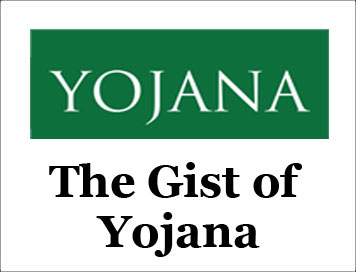(HOT) UPSC Current Affairs 2025 PDF
NEW! The Gist (NOV-2025) | E-BOOKS
(GIST OF YOJANA) Synergy of India's Armed Forces
GIST OF YOJANA : Synergy of India's Armed Forces
JUNE-2025
Synergy of India's Armed Forces
Context:
Multi-agency intelligence provided confirmation of nine major camps that were eventually targeted in the operation. India's retaliatory action was based on meticulous planning and an intelligence-led approach, which ensured that the operations were conducted with minimal collateral damage. Operational ethics were central to the mission, and restraint was exercised to avoid civilian harm.
Key roles of the CDS include
-
Overseeing the Army, Navy, Air Force, and Territorial Army.
-
Promoting jointness in procurement, training, staffing, and command restructuring.
-
Leading tri-service organisations, including cyber and space commands.
-
Advising the Nuclear Command Authority and participating in defence planning bodies.
-
Driving reforms to optimise resources, enhance combat capabilities, and reduce waste.
-
Implementing multi-year defence acquisition plans and prioritising inter-Service needs. The CDS strengthens unified leadership and fosters integration for a more coordinated and modern Indian military.
Major Government-Led Coordination Efforts Among the Armed Forces
1. Chief of Defence Staff (CDS)
On 24 December 2019, the Union Cabinet approved the creation of the post Chief of Defence Staff (CDS), a four-star General who heads the Department of Military Affairs (DMA) and acts as the principal military adviser to the Defence Minister on tri-Service matters.
2. Integrated Theatre Commands (ITCs)
- To modernise the Armed Forces, efforts are underway to restructure forces through the establishment of Integrated Theatre Commands (ITCs) and Integrated Battle Groups (IBGs). These reforms aim to optimise operational preparedness by unifying the Army, Navy, and Air Force capabilities based on geography and function. Studies at the Service Headquarters level are actively exploring Theatre Commands for Land Borders, Maritime, and Joint/Integrated Air Defence to enhance synergy and combat effectiveness. The Chief of Defence Staff (CDS) Gen Anil Chauhan has emphasised that jointness and integration are essential prerequisites for ITCs, which will clearly separate operational roles from administrative Raise-Train-Sustain (RTS) functions, allowing commanders to focus on security and operations. ITCs represent the start of wider reforms toward multi-domain operations, integratingspace and cyberspace with traditional domains, and advancing digitisation and data-centric warfare.
3. Creation of the Department of Military Affairs (DMA)
Department of Military Affairs (DMA) with CDS as Secretary was created in 2020 to facilitate optimal utilisation of resources and promote jointness among the three Services. The subjects allocated to DMA include:
- The Armed Forces of the Union, namely. Army, Navy and Air Force.
- Integrated Headquarters of the Ministry of Defence comprising of Army Headquarters, Naval Headquarters, Air Headquarters and Defence Staff Headquarters.
- Works relating to Army, Navy and Air Force. Piomoting jointness in procurement, training
- and staffing for the Services through joint planning and integration of their requirements.
- Facilitation of restructuring of Military Commands for optimal utilisation of resources by bringing about jointness in operations, including through establishment of joint / theatre commands.
4. Inter-Services Organisations (Command, Control & Discipline) Act, 2023
The Inter-Services Organisations (Command, Control & Discipline) Act, 2023 promotes jointness in the Indian Armed Forces by empowering commanders of tri-service formations with authority over personnel from all three Services. This unifies the disciplinary chain,
speeds up decision-making, and fosters operational and cultural integration. By streamlining command without affecting individual Service identities, the Act lays the legal foundation for future integrated theatre commands. Key implications of this Act are:
-
Unified command: ISO commanders can discipline all personnel under one authority.
-
Faster processes: Reduces delays from inter-Service coordination.
-
Joint culture: Encourages cross-Service cohesion and shared responsibility.
-
Legal base for theatre commands: Supports future integrated operations.
-
Service identity retained: Each Service’s unique norms remain intact.
5. Joint Logistics Nodes (JLNs)
- Three Joint Logistic Nodes (JLNs) have been established and are operational since 2021 at Mumbai, Guwahati and Port Blair for Logistics Integration between the three services. These JLNs will provide integrated logistics cover to the Armed Forces for their small arms ammunition, rations, fuel, general stores etc.
- As modem threats blur traditional boundaries. this integrated postures ensures that whether confronting aggression on the high Himalayas, securing maritime 11untieis or neutralising aerial intrusions. India stands ready, resilient. and united The future of national security firs in jointness and India is already chatting that future with purpose and resolve.
CLICK HERE TO DOWNLOAD FULL PDF
CLICK HERE TO DOWNLOAD UPSC E-BOOKS
Study Material for UPSC General Studies Pre Cum Mains
Get The Gist 1 Year Subscription Online
Click Here to Download More Free Sample Material
<<Go Back To Main Page
Courtesy: Yojana



